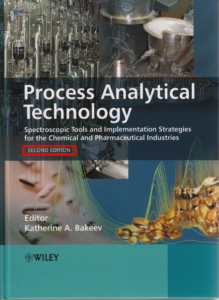Process Analytical Technology (PAT)
Process analytical technology (PAT), and its predecessor process analytical chemistry (PAC), includes
chemometric analysis and modeling based on appropriate data quality with respect to what sensor signals/measurements [X,Y] represent in the industrial process setting. Both [X,Y] data must be acquired by representative sampling, ensuring accuracy with respect to lot characteristics and precision with respect to all non-eliminated sampling and analytical errors. Chemometric data models must closely adhere to reliable performance validation, for example regarding prediction, classification, or time forecasting.
Chain of Evidence
 Without representative process sampling the chain of evidence versus lot characteristics is flawed because of inherent material heterogeneity at all scales. This applies both to samples as well as sensor signals. It is not possible to correct for nonrepresentativity deficiencies in subsequent data analytical modeling. Since analytical errors typically are one or two orders of magnitude smaller than the combined sampling errors, the dominant aspect of ‘data quality’ is in practice almost entirely dependent upon sampling. From the theory of sampling (TOS), a working minimum of principles can be outlined for both zero-dimensional (0-D, batch sampling) as well as one-dimensional (1-D) lots (process sampling), including heterogeneity characterization, systematization of eight sampling errors and seven practical sampling unit operations (SUO) with which to combat heterogeneity. Chapter 3 in “Process Analytical Technology” (see illustration): “Theory of Sampling (TOS) – the missing link in Process Analytical Technology” tells it all… Browse in chapter 3 here.
Without representative process sampling the chain of evidence versus lot characteristics is flawed because of inherent material heterogeneity at all scales. This applies both to samples as well as sensor signals. It is not possible to correct for nonrepresentativity deficiencies in subsequent data analytical modeling. Since analytical errors typically are one or two orders of magnitude smaller than the combined sampling errors, the dominant aspect of ‘data quality’ is in practice almost entirely dependent upon sampling. From the theory of sampling (TOS), a working minimum of principles can be outlined for both zero-dimensional (0-D, batch sampling) as well as one-dimensional (1-D) lots (process sampling), including heterogeneity characterization, systematization of eight sampling errors and seven practical sampling unit operations (SUO) with which to combat heterogeneity. Chapter 3 in “Process Analytical Technology” (see illustration): “Theory of Sampling (TOS) – the missing link in Process Analytical Technology” tells it all… Browse in chapter 3 here.
A Simple Set of Guidelines
The effect of non-representative sampling manifests itself as an inconstant sampling bias, which in the sampling instant can neither be estimated nor corrected for. Non-representative sampling always leads to inflated sampling variance (imprecision), which, if unnoticed, leads to futile, and unnecessary, data modeling efforts. In nearly all situations however, sampling errors can be significantly reduced and the sampling bias can in fact be completely eliminated by respecting a simple set of TOS principles and guidelines. These issues are not solved by buying a particular piece of touted equipment however, as many current OEM products unfortunately fail to respect the TOS.
- Total process measurement system validation
- A call for a regulatory paradigm shift Jan 2016
- TOS Forum 7 Minnitt and Esbensen on Pierre Gy
